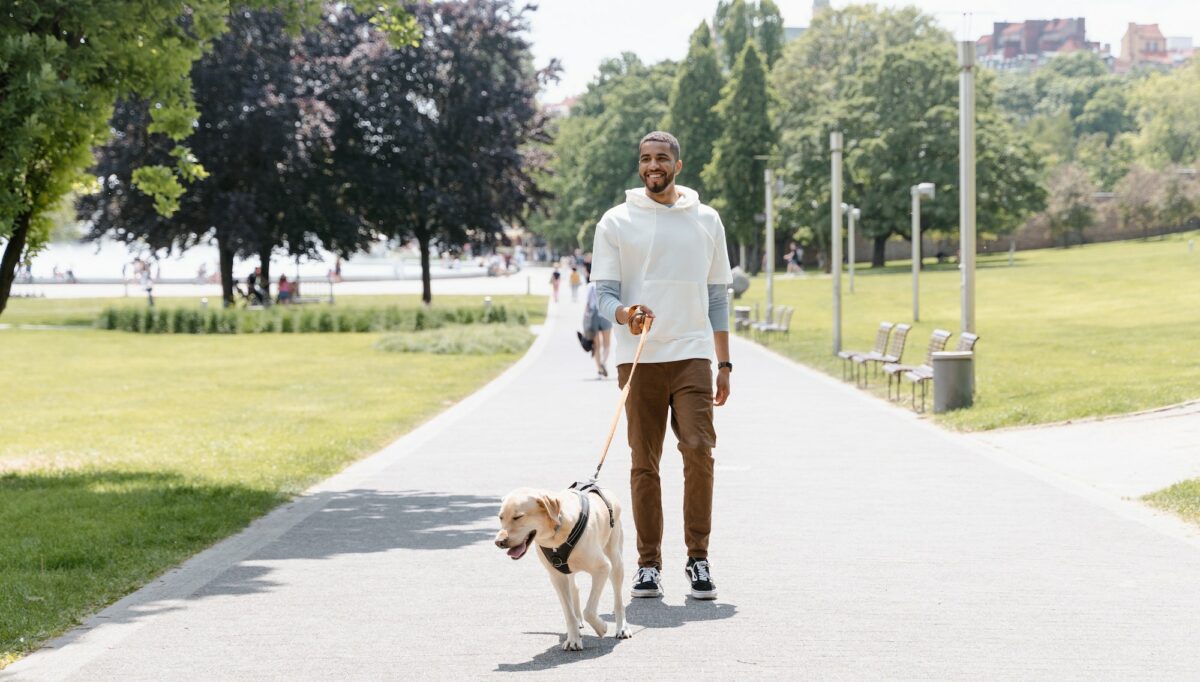Regularly walking a dog is one of the joys of dog ownership. You and your dog get outside, chat with neighbors, and get a bit of exercise. When your dog pulls on the leash, that enjoyment rapidly disappears.
Why Do Dogs Pull On The Leash?
Dogs pull on the leash because we’re slower than they are. When you leave your house heading out for a walk your dog is excited and wants to go! He wants to smell all the smells, hear all the sounds, see all the sights, and explore the neighborhood. Unfortunately, few of us want to move as quickly as dogs do.
Dogs also repeat actions that are rewarding to them. The excitement of walking, pulling hard, and sometimes even running are all rewarding. Plus, when he pulls, he gets to go somewhere. Again, this is rewarding.
Your dog is not pulling on the leash because he’s dominant, nor is he trying to achieve dominance. He just wants to explore.
Prevent Pulling
The only sure-fire way to prevent pulling is to not take your dog for a walk, but that’s not recommended. Walking your dog has so many benefits that eliminating walks really isn’t a good idea.
There are a number of chest harnesses marketed as “no pull” harnesses. These don’t teach your dog not to pull, but they can, depending on their design, slow down the pulling for a period of time so you can do some training. When choosing one, make sure the harness isn’t causing your dog harm. It shouldn’t put pressure over his joints or on the base of his neck.
Training Teaches Your Dog Not to Pull
When all good things happen to your dog on a loose leash, his need to pull disappears. The first step is to find several things that work as motivators for your dog. Some good-smelling treats are great, and a squeaky toy, tennis ball, or a tug toy may also work. Some dogs are obsessed by feathers.
For your first training session, step out your door. When your dog hits the end of the leash, stop. Hold the handle of the leash close to your body and become a statue. When your dog turns back to you, praise him, “Hey, yeah, I’m here! Good boy!” and offer a treat or toy. You are praising his attention to you. You may not go for an actual walk this first training session; in fact, you may move only a few steps. That’s okay.
When, with several practice sessions, you get to the point that you can walk a few steps, great. As you walk forward, if the leash tightens and becoming a statue doesn’t gain your dog’s attention, turn around and walk the other direction. Don’t jerk your dog off his feet; just turn around and walk. When he catches up with you, praise him, and offer him a treat or toy. Again, reward him for his attention to you.
Many dogs pull because the things that stimulate their senses are more interesting than the person on the other end of the leash. Put your phone away, pay attention to your dog, and teach him what you’d like him to do.
What Not To Do
Don’t hold the leash tight. Although experts still debate whether dogs actually have an oppositional reflex, we know that dogs will pull against a tight leash even while choking themselves. Don’t encourage that bad habit. Instead, turn the other direction and walk away from him or become a statue.
You cannot be inconsistent with loose-leash walking. If you ask him to walk nicely some of the time and ignore him, allowing him to pull, at other times, his leash skills will never be good. Remember, he pulls because walks are fun and rewarding to him. You have to be more exciting than the grass he’s sniffing.
This article was reviewed/edited by board-certified veterinary behaviorist Dr. Kenneth Martin and/or veterinary technician specialist in behavior Debbie Martin, LVT.








